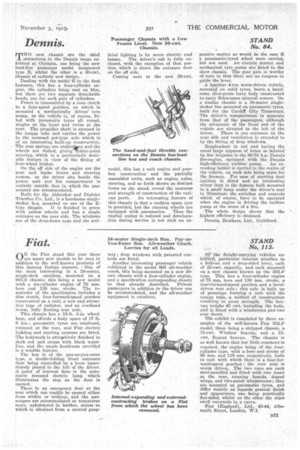Dennis.
Page 17

If you've noticed an error in this article please click here to report it so we can fix it.
rftWO new chassis are the chief
attractions in the Dennis range exhibited at Olympia, one being the new load-line passenger model designated type E, whilst the other is a 30-cwt. chassis of entirely new design. •
Dealing with the rnadel'E in the first Instance, this has a four-cylinder engine, the cylinders being cast en bloc, but there are two separate detachable heads, one for each pair of cylinders.
Power is transmitted by a cone cluteh to. a four-speed gearbox, on which is mounted a mechanically driven' tyre pump, as the vehicle i, of course, fitted with pneumatic tyres all round, singles at the front and twins at the rear. The propeller shaft is encased in the torque tube and carries the power to the reversed pot-type axle which is of an interesting built-up construction. The rear springs are unders.Waig and the -wheels are dished, giving7entre-point steering, which is a particularly desirable feature in view of the fitting of fonr-wheel brakes.
On the off side of the engine are the gear and brake levers and steering system, as the driver sits beside the power unit and his compartment is entirely outside that in which the pasaengers are accommodated.
Built for the Aldershot and District Traction Cu, Ltd., is a handsome singledecker bus, mounted on one of the E typo chaasis. It is finished in green with yellow wheels and has a single entrance on the near side. The windows are of the drop-down type and the arti ficial lighting is by seven electric roof lamps. The driver's cab is fully enclosed, with the exception of that portion which is above the entrance door on the off side.
Coming next to the new 30-cwt.
model, this has a unit engine and gearbox constructionand the partially assembled units, such as engine, axles, steering, and so forth shown • as distinct items on the stand, reveal the neatness and strength of construction of the vari ous parts. An interesting feature of this chassis is that a cushion spare tyre is provided, but the running wheels are equipped with pneumatics. Thus the capital outlay is reduced and deterictra.tion during service is not such an ex pensive matter as would be the case if a pneumatic-tyred wheel were carried, but not used. An electric starter and mechanical tyre .pump are fitted. to, the show chassis. The gear gate is worthy of note in that there are no tongues to guide the lever. A familiar 4-ton worm-driven vehicle, mounted on solid tyres, bears, a handsome olive-green lorry body constructed to carry Schweppes mineral waters. On a similar chassis is a 30-seater singledecker bus mounted on pneumatic tyres, built for the Cardiff City Tramways. The driver's compartment is separate from that of the passengers, although the occupants of the front end of the vehicle are situated to the left of the
driver. There is one entrance en the near side and ventilation is attended to by the fitting of drop windows..
Resplendent in red and having the usual large expanse of brass so beloved by fire brigades is the 60-70 h.p. Dennis fire-engine, equipped with the Dennis high-efficiency. turbine .pump. An extending ladder is carried in the centre of the vehicle, on each side being seats for the firemen. For ease of starting dual ignition is fitted and an interesting minor item is the festoon bulb mounted in a small lamp under the driver's seat to illuminate the switches and controls which, of course, have to be operated when the engine is driving the turbine pump at the scene of a fire.
The whole design shows that the highest efficiency is obtained.
Dennis, Brothers, Ltd., Guildford.
















































































